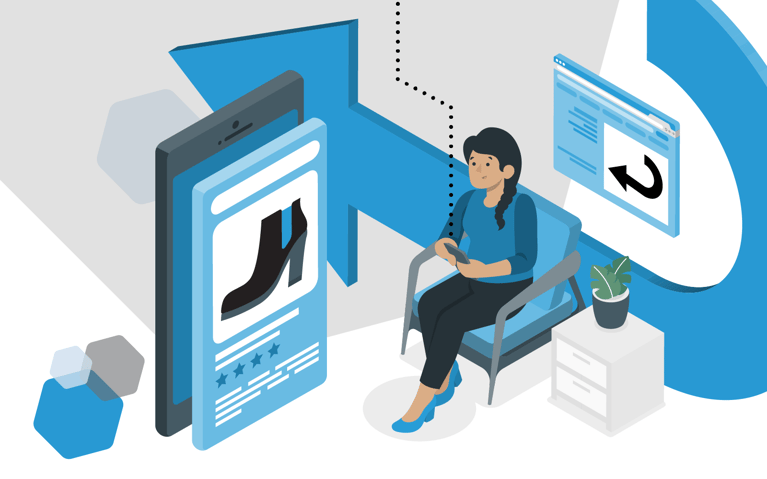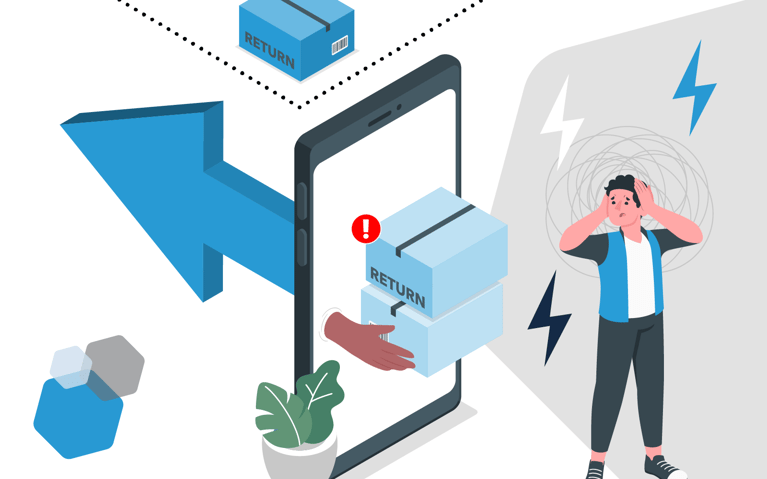A customer order ending up back where it started in the warehouse isn’t what an ecommerce business wants to see. But conditioned by years of hassle-free returns policies, consumers have come to expect easy and seamless returns that solve their pain points at a moment’s notice. It’s easy for brands to neglect reverse logistics under the guise of investing their resources in more ‘productive’ areas. But when returns are managed poorly, the rest of your operation will suffer.
Reverse logistics refers to the end-to-end process of processing, receiving and analyzing returned merchandise to maximize resale opportunities and ensure seamless customer experiences. By reducing the overhead cost of returns processing and logistics, you can reinvest these upfront costs and opportunity savings back into your business.
In this blog, we’re going to explore the true cost of reverse logistics, and what your eCommerce business can do to lessen the burden:
Understanding the costs of poor reverse logistics
Poor reverse logistics can significantly impact a company’s bottom line. In can increase the operational costs associated with handling returns, repairs and exchanges. Inefficient reverse logistics processes can also lead to higher transportation expenses, inventory holding costs and lost revenue from unsellable returned items. But most importantly, inadequate returns management can damage brand reputation and customer trust, resulting in long-term consequences for profitability and market competitiveness. Some of the most common things brands experience with poor reverse logistics includes:
High running costs
Returns refer to merchandise that has to make a return trip to your warehouse and back into storage. This means higher transportation costs, more inventory carrying costs and more labor required to organize returned items and get them ready for resale. The more returns your business needs to process, the higher these running costs will be. During return-heavy periods like the holiday season, these costs can significantly undermine your bottom line if you don’t have a streamlined process for managing returns.
Inventory depreciation and losses
Not all of the inventory that gets returned can be resold in a timely manner. If your warehouse struggles to unpack, inspect and recondition returned items so that they can be added back into your inventory, you’re at risk of accumulating excess inventory that depreciates and needs to be cleared at a discount or liquidated to make room for fresh inventory. If a lot of your capital is tied up in inventory that isn’t moving, this is harmful to business growth and profitability.
Lost sales opportunities
If reverse logistics is not managed effectively by your business, your customers WILL notice. Whether it’s long return processing times, difficulty getting refunds or the cost/time of shipping products back to the warehouse independently, poor return experiences mean poor post-purchase experiences, which have a measurable impact on customer loyalty. If the return process was full of frustration and difficulty getting the desired outcome, why would that customer want to shop with you again?
While these opportunity costs might not be immediately visible, it does contribute to higher customer churn. And when we factor in the high cost of customer acquisition in today’s ecommerce marketplace, this can cause the growth of your business to stagnate over time.
Higher carbon footprint
The cost of sending thousands of small packages on a regular basis has made ecommerce a highly carbon-intensive industry, especially when factoring in the relative inefficiency of ecommerce orders that require unique delivery routes and potentially long transit times from the warehouse to the customer’s doorstep. When reverse logistics is managed ineffectively, an ecommerce brand’s carbon emissions rise dramatically. When numerous orders are making return journeys back to the warehouse, it adds significantly to fuel and transport.
How to reduce the costs of reverse logistics
Reducing the costs of reverse logistics optimizes operational efficiency and enhances profitability. By implementing streamlined processes and innovative technologies, companies can minimize expenses associated with handling returns, repairs and exchanges. An effective cost reduction strategy in reverse logistics not only improves the bottom line but also improves the customer experience. Here are some ways to reduce costs while improving your returns management:
Invest in a proper returns management solution
Processing and approving returns manually puts a lot of pressure on your customer support team, in addition to your warehouse team. If shoppers experience a lengthy wait between requesting a return and receiving a refund or exchange, customer satisfaction will plummet. This presents a huge logistical challenge during major sales peaks like BFCM and peak holiday season, as return rates typically spike in the new year when consumers return unwanted gifts.
Using a returns automation platform enables your business to enforce your chosen return policy automatically, without requiring a human to intervene. Customers simply need to provide their order number via an online portal on your website and can lodge return or exchange requests themselves. As well as boosting customer satisfaction with the return experience, self-service returns also free up your customer support team to manage more complex tasks.
Encourage exchanges over refunds
Returns and exchanges are often lumped into the same category where reverse logistics are concerned, but there are profound differences for ecommerce businesses. An exchange represents revenue that your business has managed to retain – as well as the continuation of the customer relationship – while a return represents revenue lost. By making an effort to encourage and incentivize your customers to exchange instead of return, you can minimize revenue losses and increase the likelihood of customers continuing to shop with your brand.
For example, charging for return shipping in cases where consumers are pursuing refunds is a great way to get consumers to question the merits of returning, especially if the reason for returning is due to incorrect size or color. Alternatively, brands can offer loyalty points or a discount on a customer’s next purchase in exchange for accepting store credit instead of a refund. Rather than outright penalizing customers for making returns, this approach uses positive reinforcement to make exchanges a more attractive option.
Invest in return-ready packaging
It might be easy to overlook, but the cost of packaging contributes significantly to reverse logistics costs. If returned merchandise needs to be re-packaged over and over again to be resold, this can significantly affect your bottom line. Moreover, if customers have to re-package items to ship products back to your warehouse at their own expense, this adds friction to the return experience and could put customers off from shopping from your brand in the purchase. Return-ready packaging designs, such as resealable pouches for apparel or boxes that can be easily resealed, make returns processing more seamless and reduce your overheads.
Analyze returns data
Many returns happen due to simple change of mind, but there are also points of friction within the eCommerce shopping experience that can contribute to higher return rates–and in turn higher reverse logistics costs. For apparel and footwear brands in particular, customers are unable to test or try products in advance, meaning they are forced to rely on product imagery or sizing information to make the appropriate purchasing decision. If your brand isn’t offering a seamless shopping experience, it’s more likely that returns are going to be a persistent problem for your business.
Analyzing returns data holds the key to solving the root causes of returns at your business. For example, if customers are consistently returning a particular sweatshirt due to problems with sizing, this is a key indication that you need to consider updating your size guide and include wording such as ‘runs small’ or ‘oversized’. In doing this, customers can choose the right size accordingly and reduce returns at the source.
Streamlining reverse logistics with Cart.com
Returns are an unavoidable part of doing business as an ecommerce brand, and trying to penalize returns is not going to do your brand any favors where customer loyalty is concerned. But by making reverse logistics – and the shopping experience itself – more streamlined and efficient, you can cut operational costs and deliver more seamless experiences to customers that build loyalty and repeat purchasing behavior. It’s a win-win–both for your brand and for your customers.
Contact the experts at Cart.com today to find out how our solutions and partnerships can streamline your reverse logistics processes and help reduce costs.
About the Author

Beth Owens
Beth Owens is a content marketing professional specializing in long-form B2B content. Her primary subject area of expertise includes ecommerce, customer experience, sustainability, and digital marketing.
Read Full BioSubscribe to our emails for the latest industry insights!
By entering your email, you agree to receive marketing emails from Cart.com






